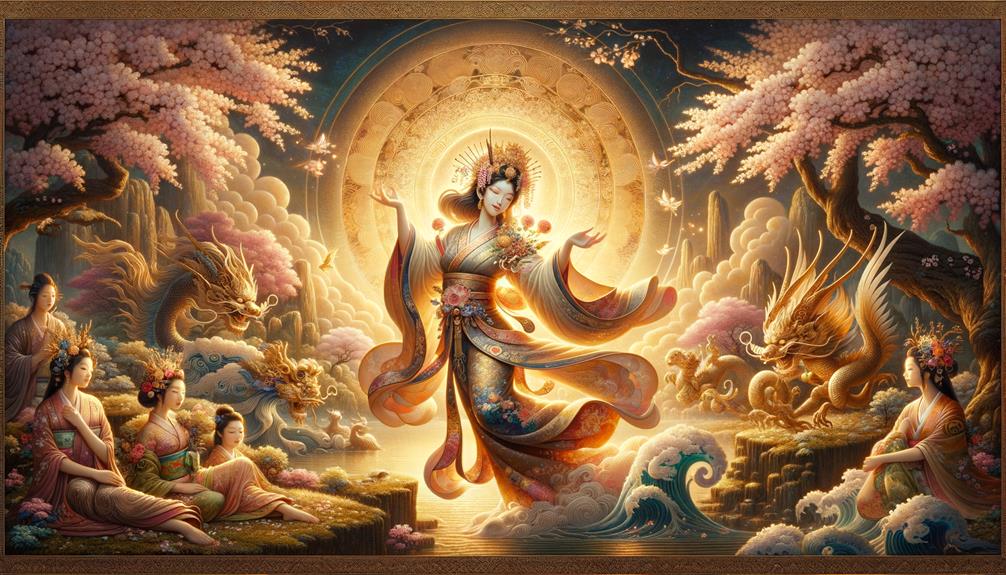In the shadows of Pandora's curiosity emerges Amenouzume's vibrant dance, a shining ritual that lifted the veil in ancient Japan's darkest moments. As the dawn goddess of Shinto mythology, her legend transcends merely coaxing Amaterasu, the sun goddess, out of her cave. It speaks to joy and creativity's transformative force. When Uzume danced, she didn't just entertain – she channeled an ancient energy bridging the divine and mortal realms, bathing our world in sacred radiance. How did her laughter and movement spark this divine awakening, birthing the sacred kagura ritual? Let's delve into the depths of her story.
Mythological Origins
In ancient Japanese folklore, we find the origins of Amenouzume, the Dawn Goddess crucial to coaxing the sun goddess Amaterasu out of hiding. Rooted in Shinto mythology, Amenouzume represents joy, creativity, and the transformative power of performing arts. Her mythic dance, a pivotal celestial moment, illuminates the profound bond between divine light and human expression.
Amenouzume stood before the cave where Amaterasu hid and performed an enchanting dance that became the sacred Shinto ritual kagura. With rhythmic movements and laughter, she captivated the other gods, evoking wonder and anticipation. This divine act wasn't mere entertainment; it symbolized hope, drawing Amaterasu out and restoring light.
Amenouzume's actions highlight universal themes of rebirth and light triumphing over darkness. Her dance brought laughter to the heavens and laid the foundation for traditional Japanese theater like noh, showcasing her enduring cultural and artistic influence. Through her story, we witness the timeless power of dance and music to heal and transform.
Amaterasu and the Cave
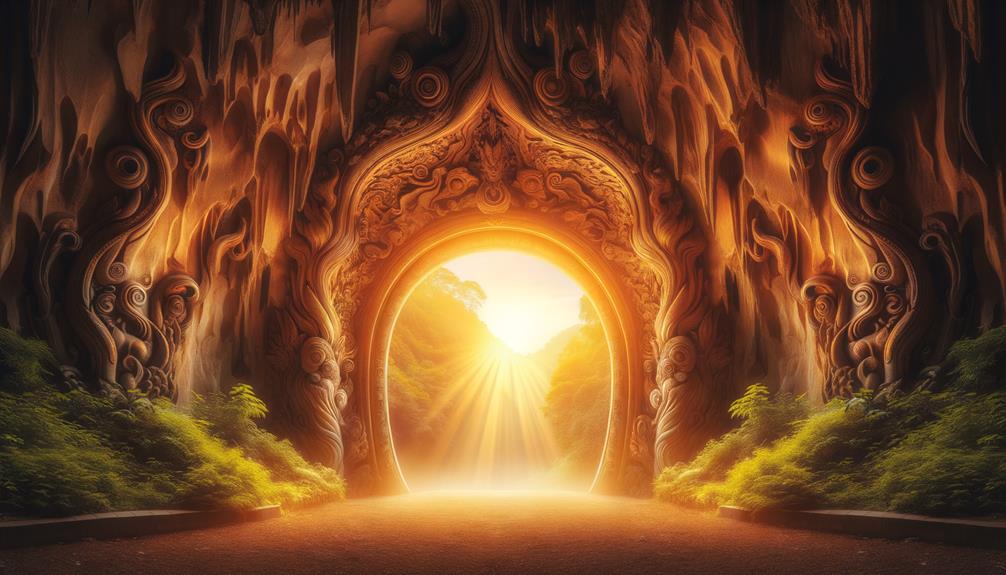
Amaterasu's retreat into the Heavenly Rock Cave shrouded the world in gloom, prompting a celestial effort to restore illumination and equilibrium. Susanoo's reckless actions – wrecking rice paddies and slaying a maiden – drove Amaterasu to seek refuge in the cave, casting the earth into obscurity. Her brilliant light's absence bred pandemonium, and the deities assembled to find a resolution.
Ame-no-Uzume, embodying the archetypal jester, stepped forward and performed a captivating dance at the cave's mouth. Her antics, brimming with playful abandon, seized the gathered gods' attention and evoked joyous laughter. This mirthful atmosphere piqued Amaterasu's curiosity, coaxing her out of seclusion.
As Amaterasu peered from the cave's entrance, the laughter and radiance of the gods' mirrors reflected upon her, reminding her of her pivotal role. Ame-no-Uzume's dance, believed to have laid the foundation for Kagura – a sacred ritual dance – was instrumental in luring Amaterasu out, restoring light to the realm and harmony to the heavens.
This narrative of Amaterasu and Ame-no-Uzume echoes universal themes of light versus darkness and order versus disarray, underscoring the transformative power of joy and community in overcoming despair.
Uzume and Sarutahiko
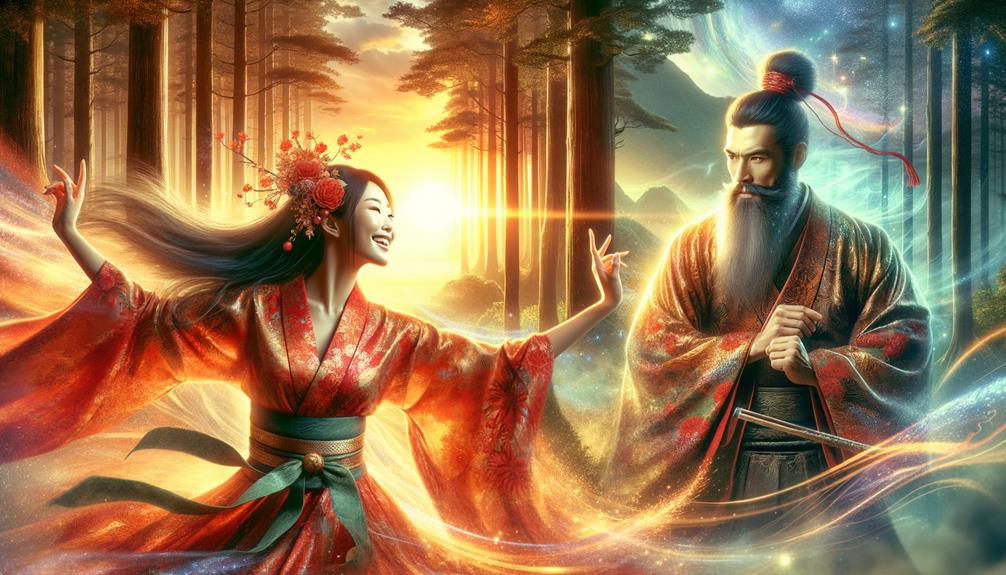
Uzume, the cheerful goddess, bumped into Sarutahiko, Heaven's intimidating bridge guard. Their encounter was pivotal, convincing Sarutahiko to let Ninigi descend to Earth – a legendary Japanese myth moment.
Their tale symbolizes timeless themes:
- Love Blossoms: Uzume and Sarutahiko fell for each other, birthing the Sarume clan.
- Transformation Prevails: Uzume's wit melted Sarutahiko's stern exterior, depicting how empathy bridges divides.
- Sacrifices Entwine Fate: Uzume cut a sea cucumber's mouth with her dagger, an act signifying sacrifice's role in destiny.
At first, Sarutahiko resisted Uzume's flirtatious charms balancing masculine and feminine energies. But together they crossed Heaven's bridge, their story lighting the way for future generations to embody love, transformation, and sacrifice's eternal truths.
Cultural Influence
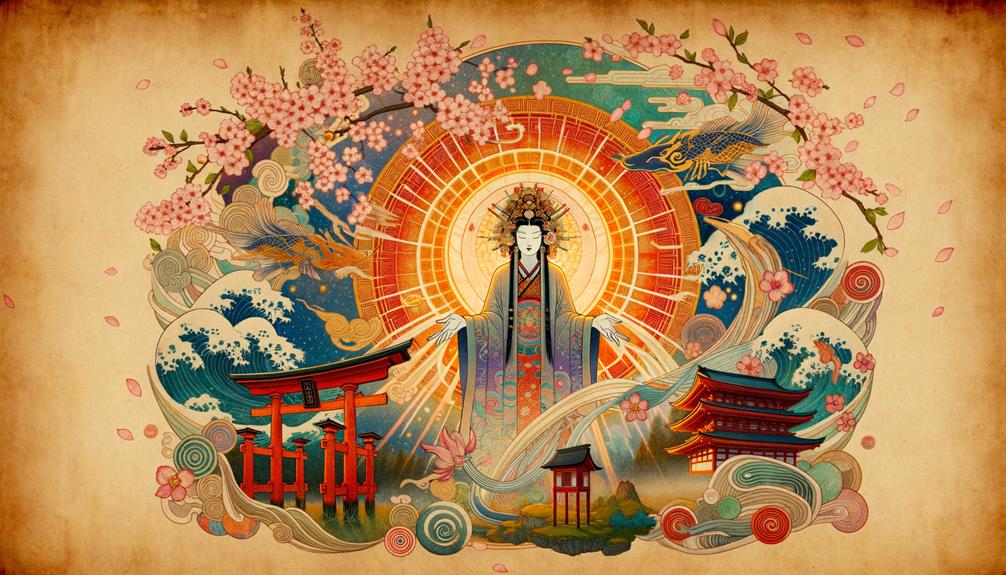
With her joyous spirit, Ame-no-Uzume dances through Japanese history, leaving an unforgettable mark on the nation's cultural identity. As the patron goddess of dancers and performers, her influence appears in various art forms like kagura and noh theater. These traditional Shinto performances echo her tale of creativity and celebration, highlighting the transformative power she represents.
In the mythical story of luring Amaterasu from her cave, Ame-no-Uzume's dance and laughter restored light to the world. This creative act underscores her symbolic role in Shinto beliefs as a figure of renewal and artistic expression. Celebrations honoring new beginnings invoke her spirit of exuberance and innovation to spread communal joy.
Beyond ancient arts, Ame-no-Uzume's story resonates in modern culture too. She features in video games like Megami Tensei and Persona, bridging mythology with contemporary storytelling. Through diverse cultural expressions spanning eras, Ame-no-Uzume continues shaping and inspiring, reminding us of art and celebration's enduring significance in our lives.
Artistic Legacy
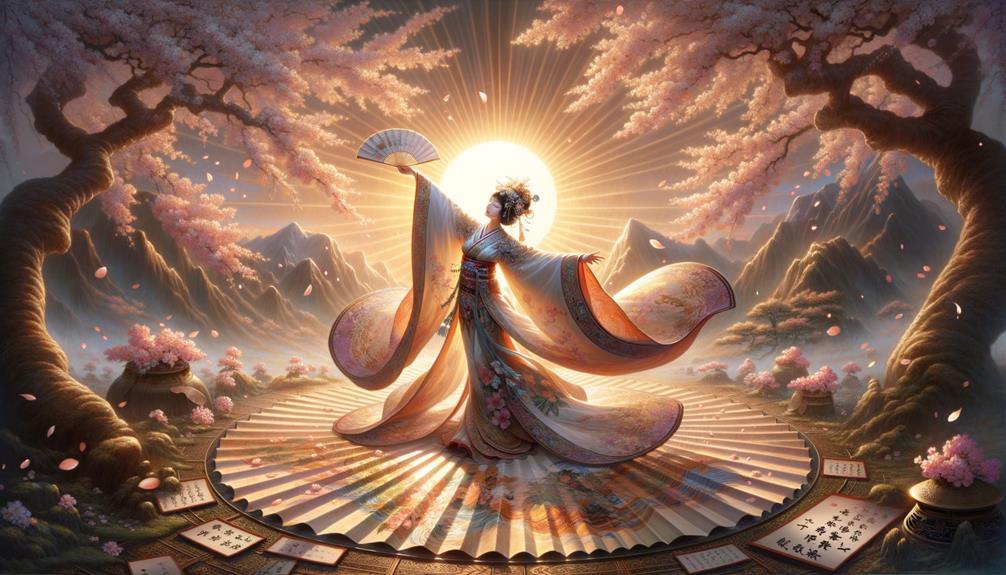
Ame-no-Uzume's boundless energy and creativity permeate Japanese culture, her artistic legacy embodying the timeless power of joyous expression and renewal. Her contributions transcend time, leaving an indelible mark on various art forms, especially traditional Japanese performances like kagura and noh theater.
Ame-no-Uzume brought dance and music into Shinto ceremonies, infusing a spirit of joy and celebration still resonating today. Her vibrant performance before the Sun Goddess Amaterasu, coaxing her out of hiding, showcases art's transformative power. This mythic act underscores several universal themes:
Joy's Release: Her dance symbolizes positive energy's release, illuminating how joy dispels darkness.
Inventive Spirit: Ame-no-Uzume inspires artists and performers to imbue their work with similar vitality.
Revitalization: Her actions encapsulate rebirth, where art brings new beginnings and revitalizes the spirit.
Through festivals and performances, Ame-no-Uzume's legacy thrives, reminding us creativity and joyful expression remain central to religious and cultural practices.
Modern Depictions
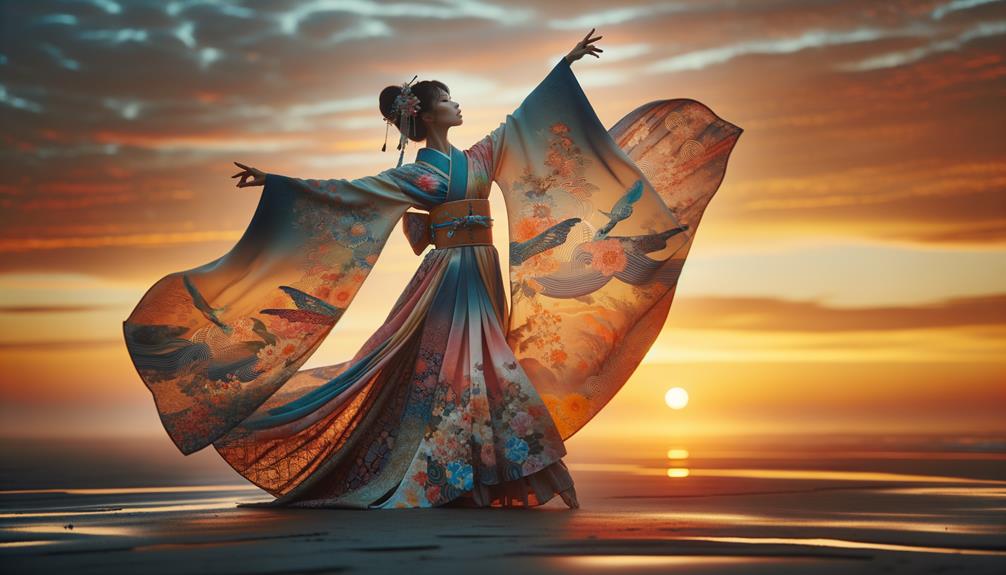
Contemporary art, movies, and books breathe new life into Amenouzume's mischievous spirit. Her joyful essence shines through, reminding us why we cherish creativity and festivities. Each modern take sees Amenouzume inspiring heroes to seek joy on their journeys, casting light on even the darkest paths.
Contemporary Art Representations
Contemporary artists interpret Ame-no-Uzume, the Goddess of Dawn and joy, with dynamic, vivid portrayals. Through vibrant colors and energetic poses, they capture her boundless spirit, interweaving her story into modern creativity. These works celebrate her connection to dance and the uplifting power she symbolizes.
Ame-no-Uzume is frequently depicted with flowing garments and a radiant smile, exemplifying the light she brings. Her joyful expression mirrors her role as a figure of renewal. Across art forms like anime and video games, her image remains one of exuberance and divine playfulness.
- Dance and Performance: Artworks highlight her influence on traditional kagura performances, portraying her as a muse of movement and rhythm.
- Playful and Mischievous: Modern takes capture her celebratory, transformative spirit with playful touches.
- Flowing Garments: Flowing robes symbolize her ethereal nature and connection to dawn.
Through these depictions, Ame-no-Uzume's mythic essence continues inspiring, bridging ancient tales with contemporary creativity.
Film and Media Portrayals
Present-day films and television take a vibrant approach to Ame-no-Uzume, the Shinto goddess of dawn and joy. Her uplifting mythological tale translates well to modern audiences. The Persona and Megami Tensei video game series skillfully capture her spirit with lively colors and energetic visuals, highlighting her connection to creativity and performance arts.
On screen, her depictions often emphasize her role as a muse for artistic expression and celebration. These modern interpretations keep the ancient folklore alive by connecting its universal themes of renewal and revelry to contemporary viewers. Ame-no-Uzume's enduring presence underscores her significance as a deity associated with the arts and as a symbol of jubilation.
Literature and Comics Adaptations
Ame-no-Uzume's mythic dance captivates modern storytelling across manga, anime, and literature. Her appearances in franchises like Megami Tensei and Persona showcase her persuasive prowess, while literary works explore universal themes like joy, creativity, and art's transformative influence. Contemporary depictions vividly portray Ame-no-Uzume coaxing Amaterasu from seclusion, resonating with the hero's journey motif and symbolizing light overcoming darkness.
- Manga and anime showcase her mythic dance's allure
- Video games like Megami Tensei explore her pivotal role
- Literature delves into timeless concepts of joy and creative expression
Ame-no-Uzume's enduring presence across media breathes life into ancient tales, enriching our grasp of archetypes and universal narratives.
Frequently Asked Questions
Who Is Ame-No-Uzume?
Ame-no-Uzume, revered as the Dawn Goddess, played a pivotal role in Japanese mythology. When Amaterasu, the Sun Goddess, retreated into a cave and plunged the world into darkness, Ame-no-Uzume's spirited dance and infectious joy coaxed Amaterasu out of hiding, restoring light. Her story symbolizes resilience, the transformative power of celebration, and the ability to overcome darkness with creativity and positivity.
Who Is the Shinto Goddess of Dawn?
Almost every Japanese person honors the ancient Shinto traditions. As Ame-no-Uzume, the Shinto goddess of dawn, I symbolize the joyous dance welcoming the morning light – new beginnings and the transformative power of celebrations.
Why Is Ame-No-Uzume Important?
Ame-no-Uzume's significance stems from her joyful spirit, restoring equilibrium by coaxing Amaterasu out of hiding. Her lively dance exemplifies the rejuvenating power of celebration, fostering resilience and spiritual renewal through traditional arts and rituals. By dispelling gloom, her actions underscore the uplifting influence of creativity and festivity.
Who Is the Husband of Ame-No-Uzume?
In Japanese folklore, Sarutahiko Okami is known as the lively deity and partner of Ame-no-Uzume. Familiar to 42% of Japanese people, their mythical union personifies cosmic harmony, leaving a lasting impact on the nation's cultural heritage and storytelling traditions. Stories featuring the husband-wife duo have endured over centuries, captivating audiences with themes of balance and heroism.

